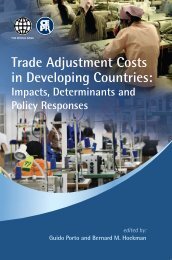Is inflation targeting dead? Central Banking After the Crisis - Vox
Is inflation targeting dead? Central Banking After the Crisis - Vox
Is inflation targeting dead? Central Banking After the Crisis - Vox
You also want an ePaper? Increase the reach of your titles
YUMPU automatically turns print PDFs into web optimized ePapers that Google loves.
Flexible <strong>inflation</strong> <strong>targeting</strong>: Performance and challengescommitment to monetary stimulus that would return <strong>the</strong>se <strong>Crisis</strong>-ravaged economies tolower levels of unemployment.More flexible <strong>inflation</strong>-<strong>targeting</strong> frameworksCan <strong>the</strong>se challenges be addressed within <strong>the</strong> <strong>inflation</strong>-<strong>targeting</strong> paradigm? Webelieve that, by enhancing <strong>the</strong> flexibility of <strong>inflation</strong>-<strong>targeting</strong> frameworks along twodimensions, <strong>the</strong>y can.• First, policymakers need more short-term flexibility in <strong>the</strong> pursuit of <strong>inflation</strong> targets.There is a need to leng<strong>the</strong>n <strong>the</strong> policy horizon beyond <strong>the</strong> conventional two years or sothat is typical of many <strong>inflation</strong>-<strong>targeting</strong> frameworks. And, we recommend specifying<strong>inflation</strong> targets in terms of a range ra<strong>the</strong>r than setting a fixed value. These changeswould enhance central banks’ ability to lean against <strong>the</strong> wind of asset-price bubbles andto provide post-<strong>Crisis</strong> monetary stimulus while preserving <strong>the</strong> main benefits of <strong>inflation</strong><strong>targeting</strong> (in particular, <strong>the</strong> anchoring of long-term <strong>inflation</strong> expectations).• Second, central banks need to continue developing and refining new policy instruments.The pre-<strong>Crisis</strong> consensus was that monetary policy should be both framed andimplemented by manipulating short-term interest rates. The thinking was that, by<strong>targeting</strong> and stabilising short-term interest rates instead of o<strong>the</strong>r intermediate financialvariables, policy would insulate <strong>the</strong> real economy from financial-sector shocks.However, <strong>the</strong> financial <strong>Crisis</strong> showed that <strong>the</strong> financial sector is connected to <strong>the</strong> realeconomy through a variety of channels, many of which are only loosely tied to <strong>the</strong> levelof short-term interest rates. Moreover, shocks from <strong>the</strong> financial sector could be solarge that policy rates reach <strong>the</strong>ir lower bound, preventing <strong>the</strong>ir fur<strong>the</strong>r use in stabilisingaggregate demand. In response, policymakers have resorted to new types of instrument,as a supplement to policy rates. The size and composition of central-bank balance sheetshave been used to target both <strong>the</strong> level and slope of <strong>the</strong> term structure of interest rates.117














